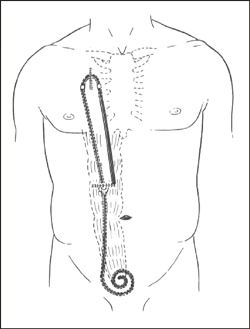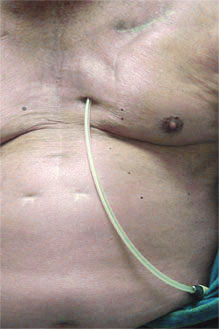The Bathtub Presternal PD Catheter
If you have kidney failure, you may have been told that you can't do peritoneal dialysis (PD) if you are obese, have an ostomy, or even if you prefer baths to showers. Think again! The less known "Bathtub" or presternal PD catheter may make PD work for you.
The presternal catheter was first used in the early 1990s at the University of Missouri by Dr. Zbylut Twardowski and his colleagues. 1 It is placed in the chest (avoiding the bra area for women) and the tip of the catheter reaches down into the abdomen (see figures 1 and 2). PD fluid drains in and out in just the same way as with an abdominal catheter, but a little slower. When the catheter is not in use, it can be held in place with tape.
| Figures used with permission from Dr. Zbylut Twardowski | |

|

|
| Figure 1: Drawing of presternal catheter | Figure 2: Photo of presternal catheter |
The catheter is a two-part tube made of silicone rubber. The two parts are joined with a titanium Luer-lock device when the catheter is placed, and stitched together. It has two cuffs that anchor it into the skin, and a coiled tip with holes to allow PD fluid to go in and out.
Benefits of a chest catheter for PD
When you stand up and sit down, your abdomen moves, which can make it hard for a PD catheter to heal well. But your chest doesn't move much. The abdomen also has more germs than the chest, since it is closer to the groin. And, belts or waistbands may rub a standard PD catheter, which can be painful and may raise your risk of infection—a presternal catheter won't be rubbed by tight clothes. If you are overweight, the fat under your skin is much thinner on your chest than on your belly, which makes it easier for the exit site to heal.
The first few patients who tried presternal catheters were adults with ostomies or children in diapers. 2 After 4 years, the new catheter had been used in 24 patients. Compared to 47 patients with standard PD catheters, presternal catheters had fewer exit site and tunnel infections. Even people who'd had many infections before had fewer problems with the presternal catheters. A number of patients chose the new catheter due to body image reasons or so they could take baths. Since the exit site is in the chest, the catheter can be kept out of the water in a bathtub. 3
After 6 years, 58 presternal catheters were compared to 86 standard catheters. Patients chose which type they wanted, with help from the care team. See Table 1 for results of this study; these were not statistically significant, but the trend suggests that presternal catheters are safe and effective for adults. 4
| Presternal Catheter | Abdominal Catheter | |
|---|---|---|
| 2-year catheter survival rates | 95% | 75% |
| Peritonitis rates | 1 per 37.4 patient months | 1 per 20.5 patient months |
| Catheters removed due to infection | 4 | 9 |
In children, studies suggest that infection rates may be lower. 5 But, there have been reports that the two parts of the presternal catheter have come apart in children, due to growth. This can be fixed, but is important to know. 6
Why presternal catheters aren't used more
"Diffusion of innovation," or the spread of new ideas, can take much longer than you'd think. Presternal catheters have been on the market for more than a decade, but they are not yet widely used—or even widely known about.
One reason these catheters may not be used as often is that they are more of a challenge to put in. Dr. Twardowski describes the surgical technique in detail in an article. 7 A video 8 and book chapter 9 have been done to help surgeons learn the new technique. Some surgeons have used a laparoscope to place presternal catheters with good results. 10 Others have kept the catheter connector end under the skin of the chest for a few weeks before starting PD. 11
What you can do
If you are doing PD now but want to be able to take baths, or if you believe a presternal catheter might allow you to do PD, print this article. Take it to your doctor and ask him or her if a presternal catheter might work for you, and if a surgeon in your area knows how to place one. The catheters are offered by Kendall Healthcare, part of Tyco Healthcare, which also makes many other types of PD catheters.
References:
- Twardowski ZJ, Nichols WK, Nolph KD, Khanna R. Swan neck presternal ("bath tub") catheter for peritoneal dialysis. Perit Dial Int. 8:316-24, 1992.
- Twardowski ZJ, Nichols WK, Nolph KD, Khanna R. Swan neck presternal peritoneal dialysis catheter. Perit Dial Int. 13 Suppl 2:S130-2, 1993.
- Twardowski ZJ, Prowant BF, Pickett B, Nichols WK, Nolph KD, Khanna R. Four-year experience with swan neck presternal peritoneal dialysis catheter. Am J Kidney Dis. 27(1):99-105, 1996.
- Twardowski ZJ, Prowant BF, Nichols WK, Nolph KD, Khanna R. Six-year experience with Swan neck presternal peritoneal dialysis catheter. Perit Dial Int. 18(6):598-602, 1998.
- Warchol S, Ziolkowska H, Roszkowska-Blaim M. Exit-site infection in children on peritoneal dialysis: Comparison of two types of peritoneal catheters. Perit Dial Int. 23(2):169-73, 2003.
- Warchol S, Roszkowska-Blaim M, Sieniawska M. Swan neck presternal peritoneal dialysis catheter: Five-year experience in children. Perit Dial Int. 18(2):183-7.
- Twardowski ZJ. Presternal peritoneal catheter. Adv Ren Replace Ther. 9(2):125-132, 2002.
- Twardowski ZJ, Nichols WK, Khanna R, et al. Swan neck presternal peritoneal dialysis catheter: Design, insertion, and break-in. Video produced by the Academic Support Center, University of Missouri, Columbia, MO.
- Twardowski ZJ, Nichols WK. Peritoneal dialysis access and exit site care including surgical aspects, in Gokal R, Khanna R, Krediet RT, et al (eds). Peritoneal Dialysis. Academic Publishers, Boston, MA, pp 307-361, 2000.
- Crabtree JH, Fishman A. Laparoscopic implantation of swan neck presternal peritoneal dialysis catheters. J Laparoendosc Adv Surg Tech A. 13(2):131-7, 2003.
- Kubota M, Kanazawa MN, Takahashi Y, Io H, Ishiguro N, Tomino Y. Implantation of presternal catheter using Moncrief technique: Aiming for fewer catheter-related complications. Perit Dial Int. 21 Suppl 3:S205-8, 2001.

